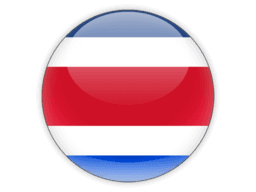
Regions of Costa Rica
Explore 7 regions
Cities of Costa Rica
Discover 76 cities across 7 regions
Alajuela Province(10)
Cartago Province(7)
Guanacaste Province(6)
Heredia Province(9)
Limón Province(5)
Costa Rica is a small Central American country known for its stunning natural beauty, eco-tourism, and commitment to environmental protection. The country is bordered by Nicaragua to the north and Panama to the south, and it is located between the Pacific Ocean and the Caribbean Sea.
Costa Rica has a diverse landscape that includes lush rainforests, active volcanoes, beautiful beaches, and wildlife-rich national parks. The country is home to a wide variety of animals, including howler monkeys, sloths, toucans, and jaguars, as well as marine life such as sea turtles and humpback whales.
The official language of Costa Rica is Spanish, and the country has a population of around 5 million people. The capital city is San Jose, which is also the largest city in the country.
Costa Rica is a stable democracy with a strong commitment to human rights, education, and healthcare. The country has a high literacy rate and is often cited as one of the happiest and most peaceful countries in the world.
The economy of Costa Rica is diverse, with the services sector being the largest contributor to GDP. The country is also known for its production of coffee, bananas, and other agricultural products. The tourism industry is also a significant contributor to the economy, with visitors drawn to the country's natural beauty and eco-tourism opportunities.
Costa Rica has a strong tradition of environmental protection, with over 25% of the country's land protected in national parks and reserves. The country has also set ambitious goals to achieve carbon neutrality by 2050 and has made significant investments in renewable energy.
Overall, Costa Rica is a country with a rich natural and cultural heritage, a commitment to sustainability and environmental protection, and a high standard of living. It remains a popular destination for travelers seeking adventure, natural beauty, and a peaceful way of life.
National holiday
Independence Day, 15 September (1821)
Telephone Code
506
Local Emergency Phone
911
Vaccinations
An International Certificate of Vaccination for yellow fever is required for travelers arriving from countries with a risk of yellow fever transmission and for travelers having transited through the airport of a country with risk of yellow fever transmission. See WHO recommendations.
Climate
Tropical and subtropical; dry season (December to April); rainy season (May to November); cooler in highlands
Currency (Code)
Costa Rican colones (CRC)
Electricity/Voltage/Plug Type(s)
120 V / 60 Hz / plug types(s): A, B
Major Languages
Spanish, English
Major Religions
Roman Catholic 71.8%, Evangelical and Pentecostal 12.3%, other Protestant 2.6%, Jehovah's Witness 0.5%
Potable Water
Opt for bottled water
International Driving Permit
Suggested; additionally, if you plan to drive in Costa Rica, you will need an Inter-American Driving Permit issued by the AAA
Road Driving Side
Right
Tourist Destinations
Manuel Antonio National Park; Poas Volcano National Park; Arenal Volcano National Park; Monteverde and the Cloud Forests; Cocos Island; Tamarindo; Mal Pais and Santa Teresa; Tortuguero National Park
Major Sports
Soccer, basketball
Cultural Practices
Local Costa Ricans are loath to say "no," instead preferring "maybe." Keep in mind that a "maybe" is not an attempt to lie or mislead.
Tipping Guidelines
Many restaurants will add a 10% service charge to the bill. If the service was good, you may leave a little extra for the server. It is standard to leave 500 CR (or $1 USD) per drink at bars. Tip tour guides between $10-15 (USD) per person depending on the size of the tour. Give $1-5 (USD) for taxi drivers depending on the distance. Round up for shorter distances. It is considerate to tip bellhops $1 (USD) per bag and leave $2 (USD) per day for housekeeping.
Souvenirs
Coffee, hammocks, ceramic and wood bowls, wooden macaw statues and other carved items, leather rocking chairs, handmade earrings and threaded necklaces
Traditional Cuisine
Gallo Pinto — kidney or black beans or pigeon peas and rice cooked together and mixed with Lizano sauce; often served as breakfast
Geography
Area
total: 51,100 sq km
land: 51,060 sq km
water: 40 sq km
Climate
tropical and subtropical; dry season (December to April); rainy season (May to November); cooler in highlands
Natural resources
hydropower
People and Society
Population
5,256,612 (2023 est.)
Ethnic groups
White or Mestizo 83.6%, Mulatto 6.7%, Indigenous 2.4%, Black or African descent 1.1%, other 1.1%, none 2.9%, unspecified 2.2% (2011 est.)
Languages
Spanish (official), English
Religions
Roman Catholic 47.5%, Evangelical and Pentecostal 19.8%, Jehovah's Witness 1.4%, other Protestant 1.2%, other 3.1%, none 27% (2021 est.)
Population growth rate
0.98% (2023 est.)
Government
Government type
presidential republic
Capital
name: San Jose
Economy
Economic overview
trade-based upper middle-income economy; green economy leader, having reversed deforestation; investing in blue economy infrastructure; declining poverty until hard impacts of COVID-19; lingering inequality and growing government debts have prompted a liquidity crisis
Real GDP (purchasing power parity)
$109.26 billion (2021 est.)
Real GDP per capita
$21,200 (2021 est.)
Agricultural products
sugar cane, pineapples, bananas, milk, oil palm fruit, fruit, oranges, watermelons, cassava, rice
Industries
medical equipment, food processing, textiles and clothing, construction materials, fertilizer, plastic products
Exports
$23.761 billion (2021 est.)
Exports - partners
United States 38%, Netherlands 6%, Belgium 5%, Guatemala 5%, Panama 5% (2019)
Exports - commodities
medical instruments, bananas, tropical fruits, orthopedic appliances, food preparations (2019)
Imports
$22.298 billion (2021 est.)
Imports - partners
United States 41%, China 13%, Mexico 7% (2019)
Imports - commodities
refined petroleum, broadcasting equipment, cars, medical instruments, packaged medicines (2019)
International Airports in Costa Rica
Discover 8 major airports serving Costa Rica
Mark Costa Rica as Visited
Add Costa Rica to your personal travel map and track your journey around the world. Share your adventures and see your progress grow!